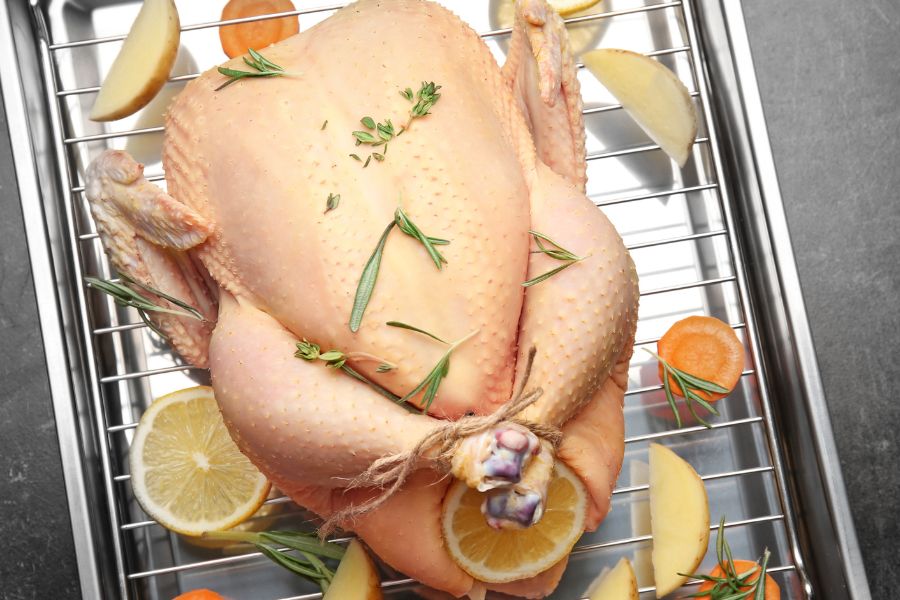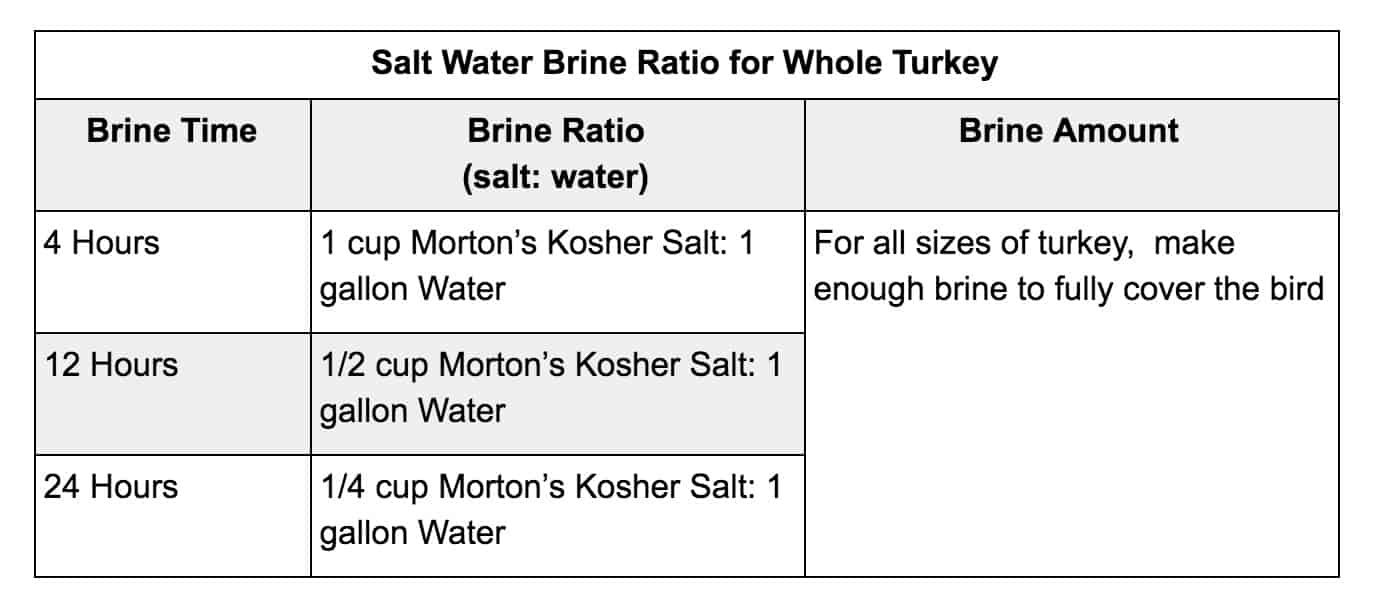Brining a turkey can help to ensure tender, juicy meat that is full of flavor. But have you ever wondered what is better – unbrined, dry brined, or salt water brined turkey? We did a side-by-side comparison. Read on for the results.
For years, I used a salt water brine to prepare my turkey for roasting. But lately it’s becoming increasingly popular for chefs and recipe developers to recommend a dry brine in which you rub the meat with salt and let it rest, allowing the salt to infuse the meat. A lot of the bigger food-centric websites (like Serious Eats and New York Times Cooking Section) recommend dry brining.
I set out to test three methods of roasting a turkey in my home kitchen. I ordered three 14-lb organic turkeys and roasted them 1) without a brine (using my Simple Roasted Turkey method), 2) with a dry brine, and 3) with a salt water brine. My recipes for dry brine and salt water brine can be found at the bottom of the post.
I rounded up some taste testers and did side-by-side comparison of the three turkeys. Results below!
Brining is a time-honored technique used by many cooks to help ensure a moist flavorful turkey on Thanksgiving and other occasions. The salt in a traditional brine helps to season the meat and keep it from drying out during roasting. However for those looking to cut back on sodium or adhere to a low-sodium diet, a salt-free turkey brine can help achieve similar results. With some creative substitutions, you can still end up with a delicious, juicy turkey without using any salt at all.
Why Brine a Turkey?
Brining involves soaking the raw turkey in a saltwater solution known as a brine, before cooking. The salt allows the turkey meat to absorb and retain moisture while also helping to season it throughout. This results in a tender, succulent turkey that is seasoned all the way to the bone. A properly brined turkey stays juicy and flavorful when cooked, as the moisture and salt is locked into the meat.
Brining does take some advance planning, as the raw turkey needs to soak in the brine solution for hours or even a full day or two before roasting. But it is a simple process that helps guarantee excellent results, making it a treasured technique for cooks wanting to impress on Thanksgiving and other holidays.
Doing Without Salt – Creative Substitutions for Brining
While salt is the star of a classic brine, there are other ways to infuse flavor and moisture into the turkey meat:
-
Herbs and spices: Rosemary, thyme, sage, garlic, and black pepper can provide seasoning without sodium. Try a brine mixture of flavorful herbs, spices, and citrus.
-
Fruit juices: Soak the turkey in a combination of fruit juices like apple, cranberry, orange, or pomegranate for sweetness.
-
Vinegars Apple cider, wine, rice, or balsamic vinegar can provide tangy flavor
-
Sweeteners: Honey, maple syrup, or brown sugar will caramelize the skin.
-
Teas: Black, green, or herbal teas lend subtle aromatic flavors.
-
Broths and stocks: Opt for low- or no-sodium chicken, turkey or vegetable broths.
-
Soy sauce/tamari: Use reduced-sodium soy sauce or tamari for umami.
-
Dry rubs: Smoked paprika, cumin, cinnamon, and more give flavor without brining.
Steps for Brining Without Salt
Brining a turkey without salt just takes a few simple steps:
-
Make the brine. Pick your favorite salt-free flavors and combine with water in a very large container. Cool in the fridge.
-
Submerge the turkey. Place the raw turkey in the brine, ensuring it is fully immersed. Use a plate to weigh it down if needed.
-
Refrigerate. Let the turkey soak in the brine solution for 8-24 hours. The timing depends on the size of the turkey.
-
Remove and pat dry. Once brined, remove the turkey and pat it very dry inside and out with paper towels.
-
Roast as usual. Cook the turkey using your preferred roasting method. The brining helps it stay moist.
-
Enjoy! You’ll have a flavorful, juicy turkey without any added sodium.
Ideas for Salt-Free Turkey Brines
There are endless options when it comes to salt-free brine ingredients. Here are just a few tasty combinations to inspire your Thanksgiving turkey:
- Apple cider, maple syrup, sage, thyme, black pepper
- Pomegranate juice, balsamic vinegar, rosemary, garlic
- Orange juice, brown sugar, cinnamon, cloves
- Apple juice, honey, smoked paprika, onions
- Cranberry juice, ginger, allspice, bay leaves
Going Without the Bird – Salt-Free Alternatives
For an even lower-sodium Thanksgiving, you can bypass turkey altogether and opt for naturally lower-sodium main dishes like:
- Roast chicken or Cornish hens
- Beef tenderloin roast
- Pork loin or crown roast
- Leg of lamb
- Seafood like salmon or halibut
- Vegetarian roasts made from lentils, mushrooms, or nuts
Tips for Salt-Free Thanksgiving Flavor
While turkey and traditional sides are customary, getting creative with seasonings can reduce the need for added salt:
-
Infuse flavor into vegetables by roasting, caramelizing, or sautéing in broth.
-
Don’t forget herbs and spices! Sage, thyme, rosemary, cloves, and more pack a flavor punch.
-
Make gravies and sauces from pan drippings and thickened with flour or cornstarch instead of broth.
-
Boost umami with sautéed mushrooms, roasted garlic, or a splash of Worcestershire sauce.
-
Brighten with citrus like orange, lemon, lime, or cranberry. Zest adds lots of flavor.
-
Sweeten with pure maple syrup, honey, molasses, or brown sugar. A touch of sweetness balances seasonings.
The Takeaway on Salt-Free Brining
While brining often relies heavily on salt, there are many creative ways to infuse a turkey or other poultry with delicious flavor and moisture without sodium. Herbs, spices, vinegars, juices and other ingenuity can help achieve a succulent, crave-worthy turkey for the holidays. With some simple substitutions and advance planning, you can enjoy all the delicious tastes of the season while sticking to a low-sodium diet.

Salt Water Brine Ratio for 4, 12, and 24 hours
The ratio of salt to water in a brine doesn’t need to be changed based on the size of the turkey, but it should be changed based on the time you plan to brine the bird. Here is a good guide:

What is a brine?
A brine is the process of treating meat with a salt solution. There are two types of brines – a dry brine and a wet (salt water) brine. Dry brining is done by rubbing the meat with salt while a wet brine is done by soaking the meat in salt water.
Both methods use more salt than you would use if you were to salt the turkey right before roasting because the salt has time to soak into and infuse the meat. You can add additional flavor to any brine using sugar, herbs, spices, or citrus.
How to Brine a Turkey
FAQ
Can you brine a turkey with no salt?
No, turkey brine does not have to have sugar. Salt in water is the most basic and important way to brine. The salt causes the entire turkey to become tender by breaking down the proteins of the turkey. Water allows the salt and flavors to be soaked in easily.
What is an alternative to brining a turkey?
Brining Alternatives. By far the most common alternative is plain old salting. When you salt a turkey (or chicken) breast, meat juices are initially drawn out through the process of osmosis (yes, this time it really is osmosis at work).
Can you brine without salt?
You cannot brine without salt.
What can I use instead of salt brine?
Potassium chloride provides the same negative ions as table salt, and thus has a nearly identical effect when used in a brine. The bottom line: It’s fine to brine with a salt substitute. Just be sure to use a low-salt (not a salt-free) brand.
Can You brine a turkey without salt?
However, for those looking to reduce their sodium intake or adhere to a low-sodium diet, brining a turkey without salt is a viable option. While salt is a key ingredient in traditional brining recipes, there are alternative brining solutions that can still impart flavor and moisture to the turkey without the use of salt. Do you like this article?
What is a good substitute for salt when brining a Turkey?
There are several ingredients that can be used as alternatives to salt when brining a turkey. One popular option is using a combination of herbs and spices such as rosemary, thyme, sage, and black pepper, along with citrus fruits like orange or lemon to infuse flavor into the meat.
Can You brine without salt?
Brining without salt opens up a world of creative possibilities in the kitchen. By exploring alternative flavor-enhancing ingredients and techniques, you can achieve the same juicy and flavorful results as traditional brining methods, without relying on salt.
Do I need to Salt a turkey breast After brining?
This juicy roast turkey breast was marinated overnight in a mixture that included maple syrup, mustard and apple juice. Unlike brine, a marinade is not loaded with salt. ADRIAN LAM Dear Eric: I’m assuming that after brining a turkey, it is not necessary to again salt, or add other herbs to the bird?
Should you brine if you’re on a salt-restricted diet?
A generous amount of salt, often a cup or more, is the key ingredient in brine, and without it you won’t get the moister results noted above. Thus brining is something to avoid if you’re on a salt-restricted diet. If you used another ingredient in place of salt, you wouldn’t be brining — you’d be marinating.
How do you brine a Turkey?
Place all ingredients in a large, non-reactive (not aluminum) pot and bring to a boil. Remove from the heat and let cool. To brine a turkey, place it in a food-safe bucket or large non-reactive pot and pour the brine over it. Refrigerate and let turkey sit overnight in the brine. Remove turkey from brine and roast as usual.
